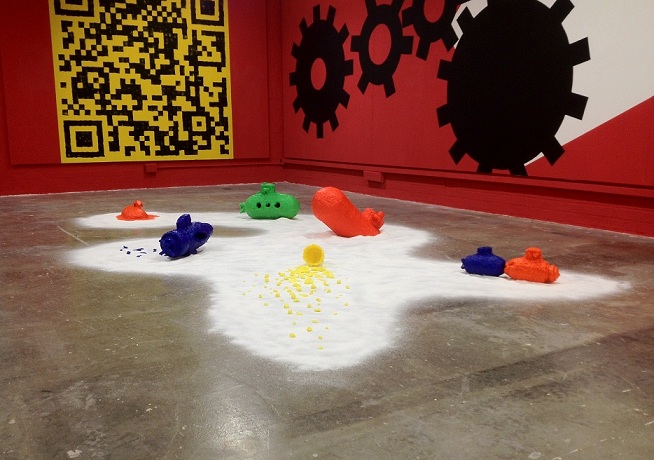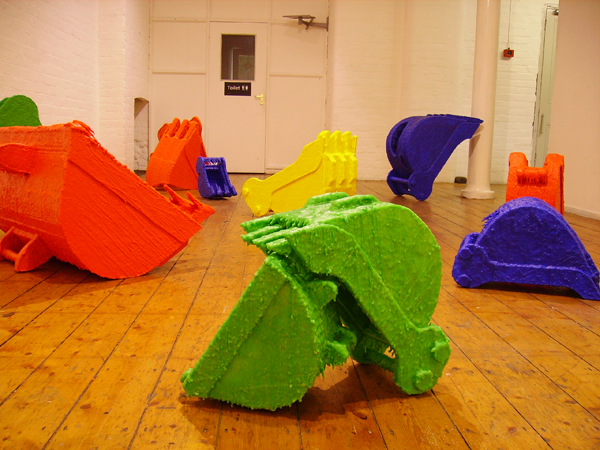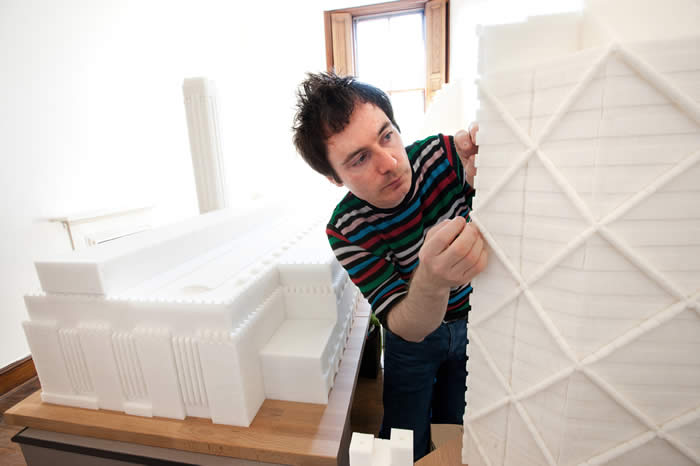| |
23 February 2012 VISUAL ARTS REVIEW: Interplanetary Revolution By John Higgins
Interplanetary Revolution at the Golden Thread Gallery in Belfast is named for a 1924 propaganda cartoon, a savagely crude mix of stop-motion and cell animation, featuring 'Comrade Cominternov, who flew to Mars and vanquished all the capitalists on the planet!' It’s a three ring circus, with three separate curators rubbing shoulders under this singular and apt umbrella. I’ve never seen a show like it, and it is a show. The Factotum Choir perform a rousing version of 'Paradox', a song from a 1960’s General Electric album of motivational songs extolling the paradoxical virtues of silicone. Shiro Masuyama’s 'Parky Party' is a silent bar, where drinkers/audiences pick from a list of cocktails to be consumed in a curtained booth, wearing headphones. If this was an attempt to undermine the bourgeois notion of convivial social drinking, it seems that tonight the patrons of the Golden Thread genuinely relish the idea of drinking quietly and alone. Then again, these are art folk! To pay for drinks you needed a newly minted currency, 'The Revolution'. Three of which would get you a marguerita, which puts it head and shoulders above that other made up currency, the Euro. The show’s expressed intention to explode assumptions and subvert relationships is exemplified by its protean ethos. Parts of the exhibition will change, some are unfinished and some may never be finished. There are also lunchtime discussions and evening screenings over the run of the exhibition. Colin Darkes’s 'Parados GTG' consists of 60 oil-on-canvas paintings of Lenin addressing a crowd, taken from an old news-reel. The pictures have been photographed as a stop-motion animation and reproduced on a television screen as a beautifully realised flick-book; the creamy, pearlescent shades of grey mimic the silver sheen of celluloid. Brendan Jamison’s 'Submarine Series' sees a clutch of the Haribo bright submersibles cresting on a sea of sugar, while English art duo The Girls exhibit Smurfette as a Vargas model from his blue period. She is necessarily hypothermic, something exemplified by cork-like nipples on her plastic breasts. Ryan Moffett’s video work, shot at night in County Fermanagh, shows a world of gnarled and spooky trees. Tighter shots, excising context, reveal a peculiar alien landscape, the black ribs of tree roots haloed by phosphorescence, strange crenulations with the texture of a Max Ernst frottage landscape. Charles Burns, author of Dog Boy and an advertising campaign for failed beverage OK Soda, is represented by a copy of his Black Hole graphic novel. It is a tale of a teenage sexual plague ravaging 1970s Seattle. Symptoms may vary from the relatively benign – a spare pair of neck lips – to the somewhat more noticeable, sprouting horns and shedding all your skin. Burns’ classy, clear-line style remains instantly recognisable, and the story has a clammy intensity. The influence of David Cronenberg and Lynch, with their respective 'body-horror' and 'small-town-American-weirdness' tropes, does, however, cast a big 80s pop-cultural shadow over the work. Gerry Gleason’s 'Potemkin' presents us with the contradiction of constructivist painting and Miro’s figurative abstraction. It is a powerfully delineated crystalline concoction, with its skirt of geometric planes, a contraction of ship and iceberg and a vessel to threaten Belfast if ever there was one. And in this year of all years! Jonas Mekas’ 'The Brig' (1964, above) is a fake documentary about ten confined soldiers and the three guards who subject them to beatings, degradations and senseless rituals. The film is both immersive and repellent. The prisoners seem terrified and yet rigorously choreographed, and parts of the action seem so adroitly synchronised that it is hard to believe what you’re seeing is real. Equally it’s impossible to believe that a camera, an unnoticed camera, at that, would be allowed to record this barbarity. Yet there is such naturalism in the lighting, that you forget you watching something that is not 'true'. Mekas’ camera work is uncertain, sometimes witnessing the violence, sometimes only catching up with a prone, gasping body. Combined with the mumbled or bellowed performances, the grainy 'found' quality of the film, with its French subtitles, it convinces enough to disconcert. It is cinema’s greatest trick described here by something that doesn’t look like cinema at all. Interplanetary Revolution runs until March 24.
_________________________________________________________________________________
27 January 2011 VISUAL ARTS REVIEW: London Art Fair By Ciaran McCauley
124 exhibit, only one is Irish. Belfast's Golden Thread represent the old and the new
Rising star Brendan Jamison, whose sugar cube sculptures were shown recently at Sotheby's and the London Festival of Architecture, this time works with wood: wooden JCB digger buckets encased in brightly coloured wax litter the floor (pictured above)
McCAULEY, CIARAN. "Visual Arts Review: London Art Fair", Culture Northern Ireland, Belfast, 27 January 2011 ____________________________________________________________________________________________________________
24 June 2010
Brendan Jamison 71908 things to do with a ton of sugar and a commission from the London Festival of Architecture
Jamison has always been artistic. ‘From a very young age I was making art in one some form. It was always three-dimensional. I was either up in my room building things from Lego or out in the backyard building things from wood. I was always constructing.’
MOORE, TAMMY. "Brendan Jamison: 71908 things to do with a ton of sugar and a commission for the London Festival of Architecture", Culture Northern Ireland, Belfast, 24 June 2010 ____________________________________________________________________________________________________________
White Christmas
Curator Shan McAnena explains that the colour white offers a good organising principle because, in addition to its seasonal association, 'it is no colour and all colours.' Conveniently, it’s also the colour of sugar cubes, which are exactly what Brendan Jamison used to create his whimsical, Lego-like sculptures of a fireplace, chimney and turret. They’re gorgeous - the perfect addition to any holiday table or mantelpiece. But at £2,000 for a fireplace entirely constructed of sugar, shouldn’t potential collectors be a bit worried about the object’s shelf life? 'Sugar is very enduring,' asserts McAnena. 'As long as you don’t get it wet.' White Christmas: A group show featuring White Works by Irish Artists is on view at The Naughton Gallery at Queen’s University Belfast until December 20th, 2009. Bree Hocking
HOCKING, BREE. "White Christmas: a sugar cube fireplace in the Naughton Gallery", Culture Northern Ireland online, Belfast , 1 December 2009 ________________________________________________________________________________________________________________________________
HUTCHINSON, PAUL. “Short Film Profile: Brendan Jamison”, Culture Northern Ireland online, Belfast, Summer 2007
© Brendan Jamison 2008-2012
|







